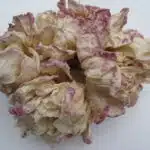Cotton Rose, also known as Hibiscus mutabilis, is a beautiful flowering plant that belongs to the family Malvaceae. It is native to East Asia where it thrives in warm and humid climates. Cotton Rose is a shrub that can grow up to 20 feet tall and is commonly cultivated for its large and showy flowers that come in shades of pink, white, or red. In this article, we will discuss the proper techniques for growing and caring for Cotton Rose in your garden.
Gardening enthusiasts who love to experiment with different varieties of plants will find Cotton Rose an interesting addition to their collection. However, growing this plant requires a certain level of knowledge and care to ensure its survival. This article aims to provide you with essential information on how to grow and care for Cotton Rose successfully. From planting tips to soil requirements, pruning techniques, pest management, and more, we will cover all the necessary steps needed to cultivate healthy Cotton Rose plants that will brighten up your garden or landscape.
Overview Of Cotton Rose
There’s an old adage that says “a rose by any other name would smell as sweet,” and the cotton rose is no exception. While not a true rose, this plant still offers many benefits to those who choose to grow it. Also known as Hibiscus mutabilis or Confederate rose, the cotton rose is a hardy shrub that produces large, showy flowers in shades of white, pink, and red.
There are several varieties of cotton rose available to suit different preferences and growing conditions. Some cultivars produce double blooms with frilly petals, while others have single blooms with a simpler appearance. The colors of the flowers can also vary depending on the variety chosen. Regardless of which type you choose, all cotton roses are relatively easy to care for and can thrive in a variety of settings.
One benefit of growing cotton roses is their long blooming period. The plants typically flower from late summer through fall, providing colorful blooms when many other plants have already finished flowering for the year. Additionally, cotton roses are relatively pest-resistant and can tolerate heat and drought once established. With their beautiful flowers and ease of care, it’s no wonder that more gardeners are choosing to add this versatile plant to their landscapes.
When it comes to growing cotton roses successfully, choosing the perfect location for your plant is crucial.
Choosing The Perfect Location For Your Plant
Cotton rose is a hardy plant that can thrive in a wide range of conditions. However, for optimal growth and flowering, it is important to choose the perfect location for your plant. One of the most important factors to consider is sunlight exposure. Cotton rose requires at least six hours of direct sunlight daily to produce healthy foliage and abundant flowers. As such, it is best to choose a location that receives full sun or partial shade.
In addition to sunlight exposure, soil composition also plays a crucial role in the growth and development of cotton rose. This plant prefers well-drained soil that is rich in organic matter such as compost or aged manure. The soil should also be slightly acidic with a pH level between 5.5 and 6.5. Before planting your cotton rose, it is advisable to test your soil’s pH level and amend it accordingly using lime or sulfur.
Overall, choosing the right location for your cotton rose is essential for its long-term success. A sunny spot with well-drained soil that is enriched with organic matter will provide the ideal growing conditions for this hardy plant. In the next section, we will discuss how to prepare your soil and plant your cotton rose effectively to ensure maximum growth and flowering potential.
Soil Preparation And Planting Techniques
- Soil pH levels should be tested before planting cotton rose to ensure the soil is sufficiently acidic for optimal growth.
- The nutrient content of the soil should be evaluated for essential elements such as nitrogen and potassium, and fertilizer applied to supplement if required.
- Planting depth should be considered when planting cotton rose as too deep or too shallow can inhibit growth.
- Soil mulching is recommended to conserve soil moisture and reduce weed pressure, while also providing insulation to the soil.
Soil Ph
Soil pH is an essential factor to consider when growing and caring for cotton rose. This plant prefers a neutral to slightly acidic soil pH ranging from 5.5 to 7.0. In acidic soil, cotton rose may struggle to absorb nutrients like phosphorus and calcium, which can lead to stunted growth and yellowing of leaves. On the other hand, in alkaline soil, the plant’s roots may not be able to uptake iron and manganese, causing chlorosis or yellowing of leaves.
To ensure that your cotton rose thrives in the right soil pH, it’s important to test the soil prior to planting. You can use a pH testing kit available at most garden centers or send a sample of your soil for analysis at a state-certified laboratory. If the pH level is below 5.5, you can amend the soil by adding lime or wood ash to raise the pH level towards neutrality. Conversely, if the pH is above 7.0, you can add sulfur or aluminum sulfate to lower it into an acceptable range.
It’s also important to note that maintaining proper soil pH levels is an ongoing process that requires periodic testing and adjustments as needed throughout the growing season. By paying attention to your cotton rose’s needs regarding soil acidity or alkalinity levels, you’ll be able to provide optimal growing conditions for this beautiful plant and enjoy its blooms for years to come.
Nutrient Content
After ensuring that the soil pH is within the optimal range for cotton rose, the next step is to prepare the soil to provide adequate nutrients for the plant’s growth. Cotton rose requires a well-draining, nutrient-rich soil that contains sufficient amounts of nitrogen, phosphorus, and potassium. Nitrogen promotes leafy growth, while phosphorus enhances root development and flower production. Potassium helps strengthen the plant’s immune system against pests and diseases.
One way to ensure that your cotton rose receives adequate nutrients is by incorporating organic matter into the soil before planting. Compost, leaf mold, or aged manure are excellent sources of organic matter that can improve soil structure and fertility. You can also add balanced fertilizer with equal amounts of nitrogen, phosphorus, and potassium according to package instructions. However, be careful not to over-fertilize as it can lead to excessive foliage growth at the expense of flower production.
Apart from providing essential nutrients for your cotton rose’s growth, incorporating organic matter into your soil has other benefits too. It improves soil water-holding capacity and aeration, prevents erosion and compaction, and encourages beneficial microorganisms’ presence in the soil. With these benefits in mind, there are many recipes available online on how to make compost or leaf mold from readily available materials such as kitchen scraps or fallen leaves.
Watering And Fertilizing
When it comes to growing and caring for cotton rose, watering and fertilizing are two of the most important factors that can greatly affect its growth and health. As an old proverb says, “water is life,” so it’s crucial to give your cotton rose enough water to thrive. However, too much water can also damage the plant’s roots and cause fungal diseases. Therefore, finding the right balance between watering frequency and amount is key.
To keep your cotton rose healthy, make sure to water it regularly during the growing season. Typically, this means watering every 7-10 days or when the soil feels dry to the touch. Keep in mind that container-grown cotton roses may require more frequent watering than those planted directly in the ground. Additionally, using a well-draining soil mix can help prevent overwatering.
In terms of fertilizing your cotton rose, there are several options for best results. Using a balanced fertilizer such as a 10-10-10 or 20-20-20 mix can provide essential nutrients for healthy growth. Organic fertilizers like compost or worm castings can also be beneficial as they improve soil quality over time. It’s best to apply fertilizer during the active growing season from spring through summer, but avoid fertilizing in winter when the plant is dormant. By following these watering and fertilizing tips, you’ll be on your way to a thriving cotton rose garden.
To further enhance your cotton rose’s growth and appearance, pruning and training are essential steps that should not be overlooked. In the next section, we’ll discuss how to properly prune and train your cotton rose for optimal performance and beauty.
Pruning And Training Your Cotton Rose
Cotton rose plants require regular pruning to maintain their shape and promote healthy growth. Pruning involves the selective removal of certain parts of the plant, such as dead or diseased branches, to improve its overall appearance and health. There are several pruning techniques that gardeners can use when caring for cotton roses.
One common pruning technique is called “pinching.” Pinching involves removing the tips of new growth with your fingers or pruning shears. This helps to encourage bushier growth and more blooms. Another technique is called “heading back,” which involves cutting back branches by one-third to one-half of their length. This helps to stimulate new growth and can even help prolong the blooming period.
In addition to pruning, training methods can also be used to shape the plant’s growth habit. One popular training method for cotton roses is called espaliering. Espaliering involves training the plant to grow flat against a wall or other support structure, which not only looks attractive but also saves space in small gardens. Other training methods include staking and trellising, which can help support tall plants and prevent them from bending or breaking under the weight of their blooms.
| Pruning Techniques | Benefits |
|---|---|
| Pinching | Encourages bushier growth and more blooms |
| Heading Back | Stimulates new growth; prolongs blooming period |
Next Section: Common Pests and Diseases to Watch For…
Cotton roses may be hardy plants, but they are still susceptible to various pests and diseases that can affect their health and vitality. In the next section, we will discuss some common pests and diseases that gardeners should watch out for when growing cotton roses. By learning how to identify these problems early on, you can take appropriate steps to prevent them from damaging your plants and ruining your garden’s beauty.
Common Pests And Diseases To Watch For
As with any plant, cotton roses are susceptible to pests and diseases. These issues can quickly turn a thriving garden into a disaster zone, so it’s important to take preventative measures to keep your cotton roses healthy. One common pest is the aphid, which feeds on the sap of plants and causes stunted growth and yellowing leaves. To prevent infestations, regularly inspect your plants for signs of pests and use insecticidal soap or neem oil as a treatment option.
Another issue cotton rose growers may face is fungal diseases such as powdery mildew or black spot. These diseases thrive in humid conditions and can spread quickly among plants. Treatment options for diseases include removing infected plant material, using fungicides or copper-based treatments, and improving air circulation around the affected area.
It’s important to note that prevention is key when it comes to combating pests and diseases in your cotton roses. Keeping a clean garden space, providing proper care for your plants including watering them adequately, and promptly addressing any signs of trouble will go a long way in keeping your cotton roses healthy. By using these preventative measures along with treatment options when necessary, you can ensure that you have beautiful blooms all season long.
As we move forward in caring for our cotton roses, it’s important to also consider how we can prepare them for colder weather. In the next section, we’ll discuss tips for overwintering your plant so you can keep enjoying its beauty year after year.
Tips For Overwintering Your Plant
As a horticulture specialist, it is important to know how to protect your cotton rose plant during the winter months. In order to ensure that your plant survives the cold temperatures, there are several winter protection methods that you can use. One of the easiest ways to protect your cotton rose is by covering it with a layer of mulch. This will help to insulate the roots from cold temperatures and prevent them from freezing.
Another effective method for protecting your cotton rose plant during the winter is through container gardening. By planting your cotton rose in a container, you can easily move it indoors when temperatures drop too low. This will allow you to control the temperature and humidity levels around your plant, which will help it survive through the winter months. Additionally, container gardening allows you to monitor your plant for any signs of pests or diseases more easily than if it were planted directly in the ground.
In order to successfully overwinter your cotton rose plant in a container, make sure that you choose a pot with good drainage and fill it with well-draining soil. You should also keep an eye on the moisture level of the soil and adjust watering as necessary. By following these tips for overwintering your cotton rose plant, you can ensure that it stays healthy and strong throughout the colder months. In our next section, we will discuss propagation methods for cotton rose plants so that you can expand your garden further.
Propagation Methods For Cotton Rose
How can you propagate cotton rose? This is a common question that many gardening enthusiasts ask. The good news is that there are two main ways to propagate cotton rose: cuttings and division. When it comes to cuttings, you need to select healthy stems from the parent plant and remove any leaves from the bottom half of the stem. Then, place the cutting in a pot with well-draining soil mix and keep it moist until roots develop. On the other hand, division involves digging up the parent plant, separating it into smaller sections, and replanting them.
Indoor or outdoor propagation also plays a crucial role in successfully propagating cotton rose. If you choose to propagate indoors, make sure to provide bright indirect light, high humidity levels, and consistent moisture levels. Outdoor propagation requires more attention to temperature fluctuations, watering frequency, and soil quality. Overall, both methods can be successful if done correctly.
To summarize, propagating cotton rose can be achieved through cuttings or division methods. Indoor or outdoor propagation also depends on environmental factors such as light exposure and moisture levels. By following these guidelines when propagating your cotton rose plants, you can ensure a healthy growth rate for your garden design needs.
Using Cotton Rose In Your Garden Design
Cotton rose, also known as Hibiscus mutabilis, is a versatile plant that can be used in various garden designs. Its beautiful flowers come in shades of pink, white, and red and bloom continuously from summer to fall. One landscaping idea is to plant cotton rose in a mixed border or as a specimen plant in a large container. It pairs well with other flowering plants such as lantana, pentas, and salvias.
Another way to use cotton rose is in floral arrangements. The flowers have a vase life of up to five days and make great cut flowers for bouquets or centerpieces. To extend their vase life, cut the stems early in the morning when the buds are just starting to open and place them immediately into water. Change the water every two days and recut the stems at an angle to keep them fresh.
Cotton rose is a low maintenance plant that adds beauty and interest to any garden design. Whether used as a landscape feature or cut flower, it will surely catch the eye of anyone who sees it. In the next section, we will answer some frequently asked questions about growing and caring for cotton rose so that you can enjoy this stunning plant even more.
Frequently Asked Questions About Cotton Rose
Cotton Rose is a versatile plant that can add beauty and texture to any garden design. However, it’s not just its appearance that makes it a valuable addition to your landscape. Cotton Rose can also attract pollinators such as butterflies and bees, making it an ecologically beneficial plant to have in your garden. To ensure that your Cotton Rose thrives in your garden, it’s essential to know how to grow and care for it properly.
To achieve the best results with your Cotton Rose, make sure to plant it in the right growing conditions. This plant requires full sun exposure and moist, well-drained soil. It’s important not to overwater the plant as this can lead to root rot. Additionally, you should fertilize the soil with organic matter before planting.
Once established, Cotton Rose blooms from spring through fall with vibrant pink or white flowers that resemble cotton balls. To prolong blooming and maintain healthy growth, regularly prune dead or diseased branches from the plant. You can also apply a balanced fertilizer during the growing season to promote better flowering.
In summary, if you want to enjoy the beauty of Cotton Rose blooming in your garden, make sure you provide ideal growing conditions for this plant. Remember to give it plenty of sunlight exposure, keep its soil moist but not waterlogged, and periodically prune dead branches while fertilizing during the growing season. Following these simple guidelines will ensure that your Cotton Rose thrives and adds value to your landscape for years to come!
Conclusion
In conclusion, growing and caring for cotton rose is a rewarding experience that requires patience, attention to detail, and knowledge of its specific needs. By choosing the perfect location, preparing the soil adequately, watering and fertilizing regularly, pruning and training appropriately, overwintering correctly, propagating with care, and using it wisely in garden design, you can enjoy the beauty and benefits of this plant for years to come.
Interestingly, cotton rose has been used traditionally for medicinal purposes by various cultures worldwide. For instance, in India, it is called “Japa Pushpa” or “the flower used in prayer,” and it is believed to have antispasmodic properties that alleviate coughs and colds. Similarly, in China, it is known as “Mugua” or “the fruit of longevity,” and it is thought to reduce inflammation and improve circulation. Therefore, besides its aesthetic value as a garden ornamental plant, cotton rose has a cultural significance that reflects its therapeutic potential. As a horticulture specialist, I encourage you to explore further the fascinating world of cotton rose and discover its many uses beyond its charm.
Image Credits





























